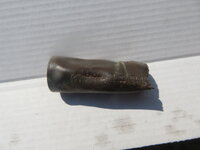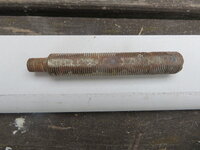Navigation
Install the app
How to install the app on iOS
Follow along with the video below to see how to install our site as a web app on your home screen.
Note: This feature may not be available in some browsers.
More options
You are using an out of date browser. It may not display this or other websites correctly.
You should upgrade or use an alternative browser.
You should upgrade or use an alternative browser.
Plane part ID wanted
- Thread starter Camo
- Start date
Ad: This forum contains affiliate links to products on Amazon and eBay. More information in Terms and rules
More options
Who Replied?SaparotRob
Unter Gemeine Geschwader Murmeltier XIII
I don't know much about aviation but the characters in the upper left look like a German font to me. Especially the number "4".
- Thread starter
- #4
Letters character is not German also no WaffenAmt stamps, German was more signed, in 500 meters radius I found American and Canadian made parts.I don't know much about aviation but the characters in the upper left look like a German font to me. Especially the number "4".
Attachments
- Thread starter
- #6
do you have some pictures to compare? I found American and Canadian made parts in 500 meter radiusThe "car 43" you see in the rectangular box is the makers code for Eisenwerk Weserhutte A.G., vorm Leobersdorfer Mascinenfabriks A.G. Leobersdorf bei Wien It. 5 Nachtrag, and dated 1943.
When I get back home I will see what I can find if you look online you will see similar codes, in various locations, for other German instruments.do you have some pictures to compare? I found American and Canadian made parts in 500 meter radius
Larrythepilot
Airman 1st Class
Assuming it's an airplane part, what would be measured on a scale of 1 to 5? How about the force of gravity, in G's? Might be the face of a G-meter.Hello All
During my last holiday in Poland I found in 500 meter radius a few part what I belive are from a plane, 100% NOT German of RussianView attachment 722538
- Thread starter
- #9
Thank you, many people told me that scale is in American gallonsAssuming it's an airplane part, what would be measured on a scale of 1 to 5? How about the force of gravity, in G's? Might be the face of a G-meter.
ThomasP
Chief Master Sergeant
The use of 1/16 increments does seem to imply it is a measure of either US or UK gallons/cups or pounds/ounces. But I believe that SparotRob and Gary Cain are correct that that it is of German manufacture - unless there is some sort of odd coincidence going on re the markings in the box, Gary Cain's identification of the German manufacturer's markings is correct. The open 4 on the gauge is typical of German markings.
The British used a closed number 4 for their gauge markings using pounds or gallons.
The US sometimes used an open 4 for their gauge markings.
Possibly it is a German war-time instrument made for use with pre-war or captured equipment of US or UK/Canadian origin or design?
The British used a closed number 4 for their gauge markings using pounds or gallons.
The US sometimes used an open 4 for their gauge markings.
Possibly it is a German war-time instrument made for use with pre-war or captured equipment of US or UK/Canadian origin or design?
Last edited:
Larrythepilot
Airman 1st Class
If you think it might be liquid measure, then what liquid would be measured in relatively small quantities? 1 to 5 of what? How about anti-icing or deicing fluid?
ThomasP
Chief Master Sergeant
Possible.
De-icing fluid.
Windshield wiper fluid.
Oil load for a small(ish) aircraft engine, or an auxiliary long range oil tank.
Fuel for an auxiliary generator.
Potable water.
??
De-icing fluid.
Windshield wiper fluid.
Oil load for a small(ish) aircraft engine, or an auxiliary long range oil tank.
Fuel for an auxiliary generator.
Potable water.
??
manta22
Banned
"8/16"??? An American instrument would not be marked with such an awkward increment.
special ed
1st Lieutenant
- 6,602
- May 13, 2018
I would suspect, if we could see the hands, they could go around twice with one hand point to the lower number and the primary hand pointing to the higher number. I.E. 16 is twice 8 rather than a fraction.
IMHO it is 8/16 (fraction) which is 1/2 or 50% of the full unit. It's only shown like this, not as 1/2, because the 1/16 is probably the important unit. We don't see the center part of the dial - maybe the units were written there. I was thinking what is 1/16 of a litre for example = 62.5mL. If this is per hour or per minute, this might be some specific liquid. Note that the odd and even positions on the dial are marked differently to make the reading easier. I think there was one hand only.I would suspect, if we could see the hands, they could go around twice with one hand point to the lower number and the primary hand pointing to the higher number. I.E. 16 is twice 8 rather than a fraction.
I've seen old machines (from my childhood) where the dials were in quarters and there was a fraction 2/4, not 1/2 e.g. for similar reasons,
Cheers!
P.S. There is a small circle in square brackets in the middle of the dial [o]- could this be degrees?
EAIAnalog
Airman
Note that there are 16 divisions between each full unit marker. Maybe 8/16 is a visual mnemonic, which shows that you are at the 1/2 point, but that each tic mark on the scale is 1/16 (of whatever).
ThomasP
Chief Master Sergeant
I am leaning toward it being a pressure gauge instrument face of some sort. The Poles used pounds on some of their oil and boost pressure gauges with 1/8 increments between the 1-2-3-4-5-6 . . whole pound marks on some of their aircraft. The range is too low for oil pressure, and there is no negative range for manifold boost pressure, so maybe for some other system that requires only positive gauge pressure?
The item in the other image in post #1 isn't an aircraft part. Looks like a fuse of some sort. Writing on it says CAP 25AMP 115V / 15AMP 230V AC.
Are we sure that the other item is even an aircraft part?
Also there is the manufacturer name on the part .. it's the FENWAL INC.
The another thing that was noticed and mentioned by Yves is the "[o] what indicates the scale in degrees. So ... perhaps a temperature controller or a part of a thermoswitch control because the Fenwal Inc. makes just such devices. Certainly if the two pieces there are related to each other.
Additionally ... taking the shape of the dial into consideration, the gauge ( device ) wasn't of the circular shape like most of aircraft indicators but of the square one. So quite modern.
MiTasol
Captain
None of which are normally fitted with a gauge. Just a dipstick on some and the rest you fill to the top or the line on the sight glass.Possible.
De-icing fluid.
Windshield wiper fluid.
Oil load for a small(ish) aircraft engine, or an auxiliary long range oil tank.
Fuel for an auxiliary generator.
Potable water.
??
Users who are viewing this thread
Total: 1 (members: 0, guests: 1)
Similar threads
- Replies
- 8
- Views
- 782


